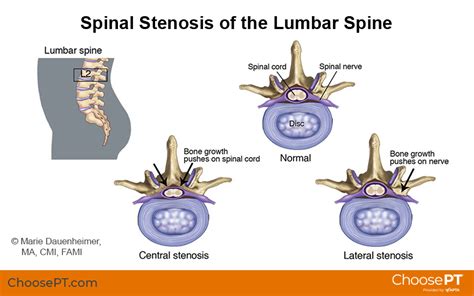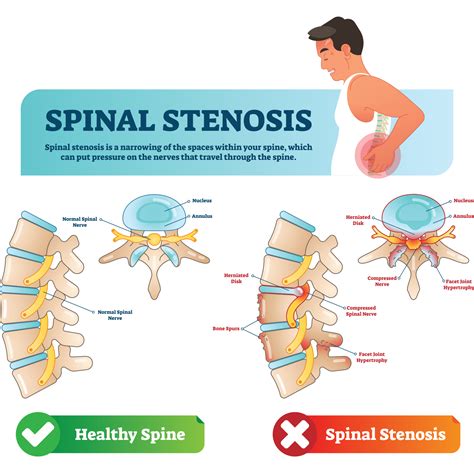Intro
Discover the causes, symptoms, and treatment options for lumbar spinal canal stenosis, a common condition affecting the lower back. Learn about the narrowing of the spinal canal, its impact on daily life, and the various therapies, including physical therapy, pain management, and surgical interventions, to alleviate pain and restore mobility.
As we age, our bodies undergo a range of natural changes that can affect our overall health and wellbeing. One common condition that affects millions of people worldwide is lumbar spinal canal stenosis, a narrowing of the spinal canal in the lower back that can cause pain, numbness, and weakness in the legs. In this article, we will delve into the causes, symptoms, and treatment options for lumbar spinal canal stenosis, providing you with a comprehensive understanding of this condition and how to manage it.
Lumbar spinal canal stenosis is a degenerative condition that occurs when the spinal canal in the lower back (lumbar spine) narrows, putting pressure on the spinal cord and nerves. This narrowing can be caused by a range of factors, including wear and tear on the spine, disc degeneration, and thickening of the ligaments and bones in the spine.

Symptoms of lumbar spinal canal stenosis can vary from person to person, but common complaints include:
- Pain, numbness, or weakness in the legs, calves, or buttocks
- Pain or cramping in the legs when walking or standing
- Difficulty walking or standing for long periods
- Tingling or burning sensations in the legs or feet
- Weakness or fatigue in the legs
Causes and Risk Factors
Lumbar spinal canal stenosis is often caused by a combination of factors, including:
- Aging: Wear and tear on the spine can cause the spinal canal to narrow over time.
- Degenerative disc disease: Degeneration of the spinal discs can cause the spinal canal to narrow.
- Spondylolisthesis: A condition in which a vertebra slips out of place, putting pressure on the spinal cord and nerves.
- Spinal injuries: Trauma to the spine can cause the spinal canal to narrow.
- Genetics: Some people may be born with a narrower spinal canal, making them more susceptible to stenosis.
Diagnosis and Testing
Diagnosing lumbar spinal canal stenosis typically involves a combination of physical examination, medical history, and imaging tests. Your doctor may perform the following tests:
- X-rays: To evaluate the alignment and structure of the spine.
- Magnetic resonance imaging (MRI): To visualize the spinal cord and nerves.
- Computed tomography (CT) scans: To evaluate the spine and surrounding tissues.
- Electromyography (EMG): To evaluate the electrical activity of the muscles.
Treatment Options
Treatment for lumbar spinal canal stenosis depends on the severity of the condition and the individual's overall health. Conservative treatment options may include:
- Physical therapy: To improve flexibility, strength, and mobility.
- Pain management: To manage pain and discomfort.
- Medications: To reduce inflammation and pain.
- Lifestyle modifications: To avoid exacerbating the condition.

In more severe cases, surgical treatment may be necessary to relieve pressure on the spinal cord and nerves. Surgical options may include:
- Laminectomy: Removing part of the vertebra to relieve pressure on the spinal cord.
- Spinal fusion: Fusing two or more vertebrae together to stabilize the spine.
- Foraminotomy: Widening the openings through which the nerves pass.
Minimally Invasive Surgery
Minimally invasive surgery is a type of surgical procedure that uses smaller incisions and specialized instruments to minimize tissue damage and promote faster recovery. Minimally invasive surgery may be an option for some people with lumbar spinal canal stenosis.
Alternative Therapies
In addition to conventional treatment options, some people may find relief from alternative therapies, such as:
- Acupuncture: To manage pain and promote healing.
- Chiropractic care: To improve spinal alignment and reduce pressure on the spinal cord.
- Massage therapy: To reduce muscle tension and promote relaxation.

Managing Lumbar Spinal Canal Stenosis
While there is no cure for lumbar spinal canal stenosis, there are steps you can take to manage the condition and reduce symptoms:
- Exercise regularly: To maintain flexibility and strength.
- Maintain a healthy weight: To reduce pressure on the spine.
- Avoid heavy lifting: To avoid exacerbating the condition.
- Improve posture: To reduce pressure on the spine.
Seeking Medical Attention
If you are experiencing symptoms of lumbar spinal canal stenosis, it is essential to seek medical attention. Early diagnosis and treatment can help alleviate symptoms and prevent further complications.
What is lumbar spinal canal stenosis?
+Lumbar spinal canal stenosis is a degenerative condition that occurs when the spinal canal in the lower back narrows, putting pressure on the spinal cord and nerves.
What are the symptoms of lumbar spinal canal stenosis?
+Symptoms may include pain, numbness, or weakness in the legs, calves, or buttocks, as well as difficulty walking or standing for long periods.
How is lumbar spinal canal stenosis diagnosed?
+Diagnosis typically involves a combination of physical examination, medical history, and imaging tests, such as X-rays, MRI, and CT scans.
What are the treatment options for lumbar spinal canal stenosis?
+Treatment options may include conservative measures, such as physical therapy and pain management, as well as surgical options, such as laminectomy and spinal fusion.
If you are experiencing symptoms of lumbar spinal canal stenosis, don't hesitate to seek medical attention. With proper diagnosis and treatment, you can manage your symptoms and improve your quality of life. Share this article with friends and family who may be experiencing similar symptoms, and encourage them to seek medical attention.
